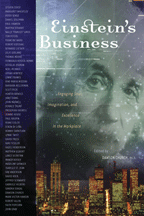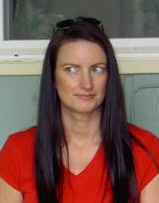“Einstein’s Business:” Chock Full of Visionaries
I’ve been dipping into the book “Einstein’s Business” for over a year. Made up of 47 essays by a host of authors, from Lynne Twist to John Gray to Riane Eisler to Steven Covey to Thomas Moore to… Donald Trump? (yes, indeedy) this book has been fun and inspiring and educational to have around. It’s easy to pick it up and flip to a particular essay, let that simmer for a bit, and then put the thing down and come back to another essay as the urge strikes.
 In addition to famous folks such as Tom Peters, Martha Stewart, and Oprah Winfrey, the book offers the writings of some not-so-famous names (Faith Popcorn, Wally “Famous” Amos) and also some I’d never heard of at all (Julie Gerland, Paul Hawken, Bari Tessler… anyone? anyone?). That’s part of what I like about this book. I get to read the work of thinkers and explorers that I’d have been unlikely to have heard of otherwise.
In addition to famous folks such as Tom Peters, Martha Stewart, and Oprah Winfrey, the book offers the writings of some not-so-famous names (Faith Popcorn, Wally “Famous” Amos) and also some I’d never heard of at all (Julie Gerland, Paul Hawken, Bari Tessler… anyone? anyone?). That’s part of what I like about this book. I get to read the work of thinkers and explorers that I’d have been unlikely to have heard of otherwise.
For example, one of my favorite essays is by Bernard Lietaer, an expert and author in “green” currencies and money systems. Mr. Lietaer inspired me very much with his case stories of money systems that discourage hoarding (the inevitable result of positive interest rates), and thus nurture community by encouraging (negative interest rates and expiration dates) money to flow in interactions and transactions between neighbors and wider community members, thus supporting more broadly shared assets between all people and a higher quality of life overall. I was fascinated by his stories of how effectively alternative systems have worked in the real world, and how fast the powerful central banks quashed them. I was struck by the reminder that money is our own creation (duh), as poignantly illustrated in the following quote:
“Money is like an iron ring we’ve put through our noses. We’ve forgotten that we designed it, and it’s now leading us around. It’s time to figure out where we want to go–and then design a money system that moves us toward sustainability and community.”
Wow. And that’s just *one* essay.
As an added bonus, each essay begins with a full page, black and white photo of the author. I really enjoyed seeing what these folks look like, especially when I had not heard of them before. I had fun initially flipping through the essays and picking out ones by authors whose faces appealed to me, a not very orderly but fun way of taking in the material.
Quoted on the inside back flap is Einstein’s quote:
“Learn from yesterday, live for today, hope for tomorrow. The important thing is not to stop questioning.”
Not every essay grabbed me so hard as Mr. Lietaer’s, but overall this book has been a deeply inspiring and mind-opening read, expanding my horizons and suggesting interesting new topics to explore, as well as individual authors to seek out and read more extensively.
